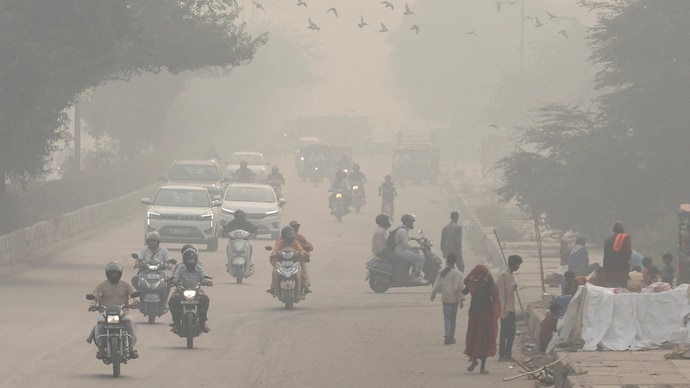
What is AQI and how does it affect your health
The composition of the Air Quality Index (AQI) is grounded in several pollutants, each of which can impact the lungs in distinctive ways.

Before Diwali celebrations even began, Delhi’s Air Quality Index (AQI) slipped to the “severe” category, putting citizens in danger of various respiratory illnesses.
WHAT IS AIR QUALITY INDEX (AQI)?
The Air Quality Index or AQI was developed by government agencies to measure the quality of air and reveal to the public the level of air pollution. The measurement ranges from the value 0 to 500.
As air pollution rises, so does the value of AQI. An AQI value of 50 or below represents good air quality, while an AQI value over 300 represents hazardous air quality.
Since AQI around Delhi and other places like Bengaluru, Mumbai and Kolkata have jumped over 500, the "hazardous" level, people can experience breathing issues, coughing, wheezing, burning of the eyes and constant sneezing.
Dr Asmita Mehta, HOD and professor of respiratory Medicine at Amrita Hospital, Kochi, told IndiaToday.In that the Air Quality Index serves as a crucial metric employed to gauge and convey the overall air quality within a specific region.
“It encompasses an array of pollutants, including particulate matter, offering a singular numerical value or index that communicates the level of air pollution,” said Dr Asmita Mehta.
WHAT IS AQI COMPOSED OF?
The composition of the AQI is based on several pollutants that can affect the lungs in different ways.
According to Dr Neetu Jain, Senior Consultant, Pulmonology Critical Care and Sleep Medicine at PSRI Hospital, several pollutions, mostly eight, namely particulate matter (PM) 10, PM2. 5, Ozone (O3), sulphur dioxide (SO2), nitrogen dioxide (NO2), carbon monoxide (CO), lead (Pb) and ammonia (NH3).
HARMFUL EFFECTS OF HIGH AQI
Dr Asmita Mehta said that when the components of air pollution, such as particulate matter (PM), along with other pollutants that contribute to the Air Quality Index (AQI), affect the lungs for a prolonged period, it can have various negative effects on respiratory health.
- Irritation and Inflammation: Prolonged exposure to elevated levels of PM and other pollutants can cause irritation and inflammation of the respiratory system, specifically the airways and lung tissue. This can lead to chronic coughing, wheezing, and throat discomfort.
- Reduced Lung Function: Continuous exposure to air pollution can result in a decline in lung function, meaning that the lungs become less efficient at moving air in and out. This can be particularly concerning for individuals with pre-existing respiratory conditions, such as asthma or chronic obstructive pulmonary disease (COPD), as it may further exacerbate their symptoms and decrease their overall lung capacity.
- Development or Worsening of Respiratory Conditions: Long-term exposure to poor air quality has been linked to the development of respiratory conditions, including asthma, bronchitis, and other chronic respiratory diseases.
- Increased Risk of Infections: Prolonged exposure to air pollution, especially PM and pollutants like nitrogen dioxide (NO2), can weaken the immune system's defenses in the respiratory tract. This leads to an increased susceptibility to respiratory infections, such as the common cold, flu, or pneumonia.
- Long-Term Health Implications: Studies have shown that prolonged exposure to high levels of air pollution can have broader health implications beyond the respiratory system such as cardiovascular diseases, including heart attacks and strokes, as well as an increased risk of lung cancer.
The composition of the Air Quality Index (AQI) is grounded in several pollutants, each of which can impact the lungs in distinctive ways.
HOW DO DIFFERENT POLLUTANTS IN AQI AFFECT THE BODY?
The most common pollutants considered in the AQI and their potential implications for respiratory health are as follows:
- Particulate Matter (PM): PM can contribute to the onset or aggravation of respiratory conditions such as asthma and bronchitis. "PM gets filtered at the upper respiratory system which is the nose. PM2.5 is the most hazardous and most health issues are caused by it. PM10 also gets filtered from the nose," said Dr Neetu Jain.
- Ozone (O3): Ozone is a gaseous pollutant with dangerous effects on the respiratory system. Inhalation of ozone can irritate the airways, causing inflammation and leading to symptoms like coughing, throat irritation, and chest discomfort. Ozone exposure can also exacerbate pre-existing respiratory conditions and diminish lung function.
- Carbon Monoxide (CO): Carbon monoxide is a colourless, odourless gas that poses a hazard when inhaled. It binds to haemoglobin in the blood, reducing its capacity to transport oxygen to the body's tissues, including the lungs. Lengthy exposure to elevated levels of carbon monoxide can result in tissue damage and respiratory problems.
- Sulfur Dioxide (SO2): Inhaling sulfur dioxide can irritate the respiratory system, precipitating symptoms such as coughing, wheezing, and shortness of breath. It can also worsen pre-existing respiratory conditions such as asthma and bronchitis.
- Nitrogen Dioxide (NO2): Nitrogen dioxide is produced by the combustion of fossil fuels. This gas can irritate the respiratory system and prolonged exposure to NO2 can lead to heightened respiratory symptoms, reduced lung function, and an increased susceptibility to respiratory infections.
The impact of each pollutant hinges on factors such as concentration, duration of exposure, individual susceptibility and other variables.


